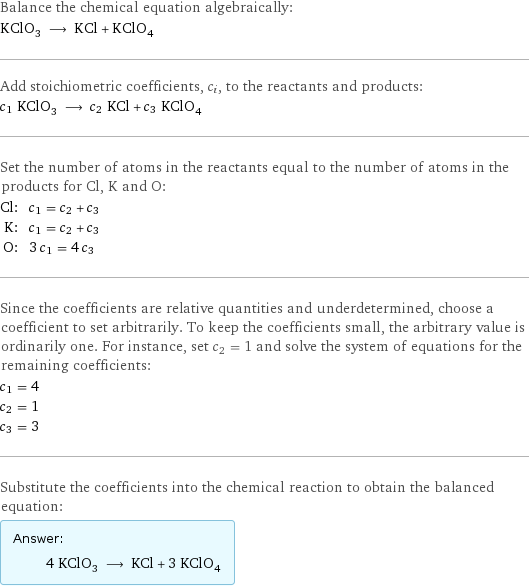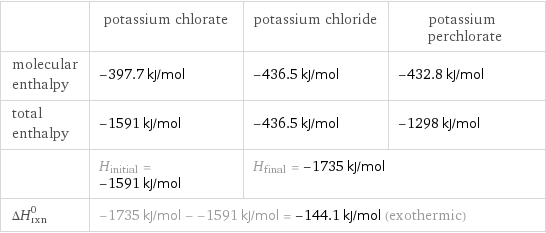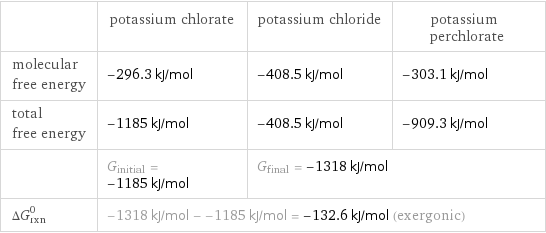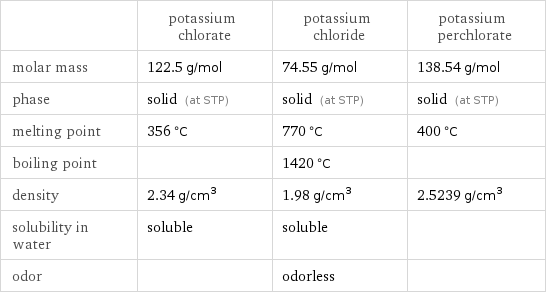Input interpretation

KClO_3 (potassium chlorate) ⟶ KCl (potassium chloride) + KClO_4 (potassium perchlorate)
Balanced equation

Balance the chemical equation algebraically: KClO_3 ⟶ KCl + KClO_4 Add stoichiometric coefficients, c_i, to the reactants and products: c_1 KClO_3 ⟶ c_2 KCl + c_3 KClO_4 Set the number of atoms in the reactants equal to the number of atoms in the products for Cl, K and O: Cl: | c_1 = c_2 + c_3 K: | c_1 = c_2 + c_3 O: | 3 c_1 = 4 c_3 Since the coefficients are relative quantities and underdetermined, choose a coefficient to set arbitrarily. To keep the coefficients small, the arbitrary value is ordinarily one. For instance, set c_2 = 1 and solve the system of equations for the remaining coefficients: c_1 = 4 c_2 = 1 c_3 = 3 Substitute the coefficients into the chemical reaction to obtain the balanced equation: Answer: | | 4 KClO_3 ⟶ KCl + 3 KClO_4
Structures

⟶ +
Names

potassium chlorate ⟶ potassium chloride + potassium perchlorate
Reaction thermodynamics
Enthalpy

| potassium chlorate | potassium chloride | potassium perchlorate molecular enthalpy | -397.7 kJ/mol | -436.5 kJ/mol | -432.8 kJ/mol total enthalpy | -1591 kJ/mol | -436.5 kJ/mol | -1298 kJ/mol | H_initial = -1591 kJ/mol | H_final = -1735 kJ/mol | ΔH_rxn^0 | -1735 kJ/mol - -1591 kJ/mol = -144.1 kJ/mol (exothermic) | |
Gibbs free energy

| potassium chlorate | potassium chloride | potassium perchlorate molecular free energy | -296.3 kJ/mol | -408.5 kJ/mol | -303.1 kJ/mol total free energy | -1185 kJ/mol | -408.5 kJ/mol | -909.3 kJ/mol | G_initial = -1185 kJ/mol | G_final = -1318 kJ/mol | ΔG_rxn^0 | -1318 kJ/mol - -1185 kJ/mol = -132.6 kJ/mol (exergonic) | |
Entropy

| potassium chlorate | potassium chloride | potassium perchlorate molecular entropy | 143 J/(mol K) | 83 J/(mol K) | 151 J/(mol K) total entropy | 572 J/(mol K) | 83 J/(mol K) | 453 J/(mol K) | S_initial = 572 J/(mol K) | S_final = 536 J/(mol K) | ΔS_rxn^0 | 536 J/(mol K) - 572 J/(mol K) = -36 J/(mol K) (exoentropic) | |
Equilibrium constant
![Construct the equilibrium constant, K, expression for: KClO_3 ⟶ KCl + KClO_4 Plan: • Balance the chemical equation. • Determine the stoichiometric numbers. • Assemble the activity expression for each chemical species. • Use the activity expressions to build the equilibrium constant expression. Write the balanced chemical equation: 4 KClO_3 ⟶ KCl + 3 KClO_4 Assign stoichiometric numbers, ν_i, using the stoichiometric coefficients, c_i, from the balanced chemical equation in the following manner: ν_i = -c_i for reactants and ν_i = c_i for products: chemical species | c_i | ν_i KClO_3 | 4 | -4 KCl | 1 | 1 KClO_4 | 3 | 3 Assemble the activity expressions accounting for the state of matter and ν_i: chemical species | c_i | ν_i | activity expression KClO_3 | 4 | -4 | ([KClO3])^(-4) KCl | 1 | 1 | [KCl] KClO_4 | 3 | 3 | ([KClO4])^3 The equilibrium constant symbol in the concentration basis is: K_c Mulitply the activity expressions to arrive at the K_c expression: Answer: | | K_c = ([KClO3])^(-4) [KCl] ([KClO4])^3 = ([KCl] ([KClO4])^3)/([KClO3])^4](../image_source/1f2ebece9f3d23cdcdff7f869975eea2.png)
Construct the equilibrium constant, K, expression for: KClO_3 ⟶ KCl + KClO_4 Plan: • Balance the chemical equation. • Determine the stoichiometric numbers. • Assemble the activity expression for each chemical species. • Use the activity expressions to build the equilibrium constant expression. Write the balanced chemical equation: 4 KClO_3 ⟶ KCl + 3 KClO_4 Assign stoichiometric numbers, ν_i, using the stoichiometric coefficients, c_i, from the balanced chemical equation in the following manner: ν_i = -c_i for reactants and ν_i = c_i for products: chemical species | c_i | ν_i KClO_3 | 4 | -4 KCl | 1 | 1 KClO_4 | 3 | 3 Assemble the activity expressions accounting for the state of matter and ν_i: chemical species | c_i | ν_i | activity expression KClO_3 | 4 | -4 | ([KClO3])^(-4) KCl | 1 | 1 | [KCl] KClO_4 | 3 | 3 | ([KClO4])^3 The equilibrium constant symbol in the concentration basis is: K_c Mulitply the activity expressions to arrive at the K_c expression: Answer: | | K_c = ([KClO3])^(-4) [KCl] ([KClO4])^3 = ([KCl] ([KClO4])^3)/([KClO3])^4
Rate of reaction
![Construct the rate of reaction expression for: KClO_3 ⟶ KCl + KClO_4 Plan: • Balance the chemical equation. • Determine the stoichiometric numbers. • Assemble the rate term for each chemical species. • Write the rate of reaction expression. Write the balanced chemical equation: 4 KClO_3 ⟶ KCl + 3 KClO_4 Assign stoichiometric numbers, ν_i, using the stoichiometric coefficients, c_i, from the balanced chemical equation in the following manner: ν_i = -c_i for reactants and ν_i = c_i for products: chemical species | c_i | ν_i KClO_3 | 4 | -4 KCl | 1 | 1 KClO_4 | 3 | 3 The rate term for each chemical species, B_i, is 1/ν_i(Δ[B_i])/(Δt) where [B_i] is the amount concentration and t is time: chemical species | c_i | ν_i | rate term KClO_3 | 4 | -4 | -1/4 (Δ[KClO3])/(Δt) KCl | 1 | 1 | (Δ[KCl])/(Δt) KClO_4 | 3 | 3 | 1/3 (Δ[KClO4])/(Δt) (for infinitesimal rate of change, replace Δ with d) Set the rate terms equal to each other to arrive at the rate expression: Answer: | | rate = -1/4 (Δ[KClO3])/(Δt) = (Δ[KCl])/(Δt) = 1/3 (Δ[KClO4])/(Δt) (assuming constant volume and no accumulation of intermediates or side products)](../image_source/f5e75f401993351ffbb5d510ee661b21.png)
Construct the rate of reaction expression for: KClO_3 ⟶ KCl + KClO_4 Plan: • Balance the chemical equation. • Determine the stoichiometric numbers. • Assemble the rate term for each chemical species. • Write the rate of reaction expression. Write the balanced chemical equation: 4 KClO_3 ⟶ KCl + 3 KClO_4 Assign stoichiometric numbers, ν_i, using the stoichiometric coefficients, c_i, from the balanced chemical equation in the following manner: ν_i = -c_i for reactants and ν_i = c_i for products: chemical species | c_i | ν_i KClO_3 | 4 | -4 KCl | 1 | 1 KClO_4 | 3 | 3 The rate term for each chemical species, B_i, is 1/ν_i(Δ[B_i])/(Δt) where [B_i] is the amount concentration and t is time: chemical species | c_i | ν_i | rate term KClO_3 | 4 | -4 | -1/4 (Δ[KClO3])/(Δt) KCl | 1 | 1 | (Δ[KCl])/(Δt) KClO_4 | 3 | 3 | 1/3 (Δ[KClO4])/(Δt) (for infinitesimal rate of change, replace Δ with d) Set the rate terms equal to each other to arrive at the rate expression: Answer: | | rate = -1/4 (Δ[KClO3])/(Δt) = (Δ[KCl])/(Δt) = 1/3 (Δ[KClO4])/(Δt) (assuming constant volume and no accumulation of intermediates or side products)
Chemical names and formulas

| potassium chlorate | potassium chloride | potassium perchlorate formula | KClO_3 | KCl | KClO_4 Hill formula | ClKO_3 | ClK | ClKO_4 name | potassium chlorate | potassium chloride | potassium perchlorate
Substance properties

| potassium chlorate | potassium chloride | potassium perchlorate molar mass | 122.5 g/mol | 74.55 g/mol | 138.54 g/mol phase | solid (at STP) | solid (at STP) | solid (at STP) melting point | 356 °C | 770 °C | 400 °C boiling point | | 1420 °C | density | 2.34 g/cm^3 | 1.98 g/cm^3 | 2.5239 g/cm^3 solubility in water | soluble | soluble | odor | | odorless |
Units
